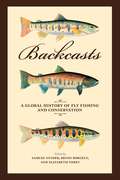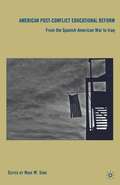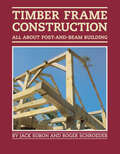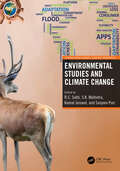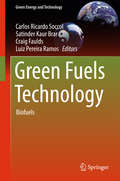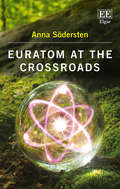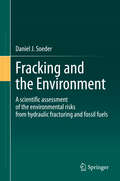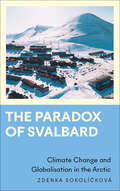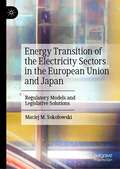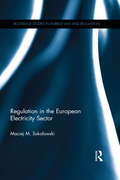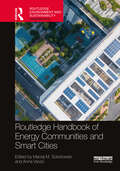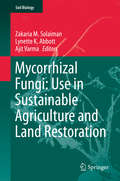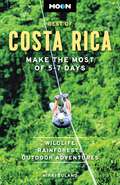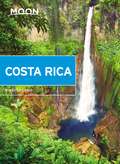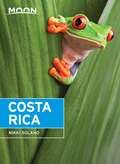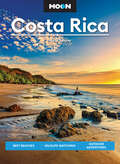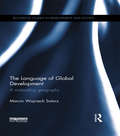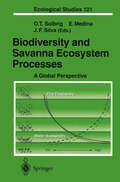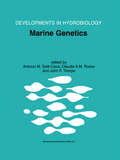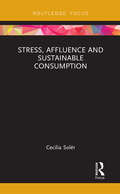- Table View
- List View
Backcasts: A Global History of Fly Fishing and Conservation
by Samuel Snyder Bryon Borgelt Elizabeth Tobey James Prosek Chris Wood Jen Corrinne Brown“Many of us probably would be better fishermen if we did not spend so much time watching and waiting for the world to become perfect.”-Norman Maclean Though Maclean writes of an age-old focus of all anglers—the day’s catch—he may as well be speaking to another, deeper accomplishment of the best fishermen and fisherwomen: the preservation of natural resources. Backcasts celebrates this centuries-old confluence of fly fishing and conservation. However religious, however patiently spiritual the tying and casting of the fly may be, no angler wishes to wade into rivers of industrial runoff or cast into waters devoid of fish or full of invasive species like the Asian carp. So it comes as no surprise that those who fish have long played an active, foundational role in the preservation, management, and restoration of the world’s coldwater fisheries. With sections covering the history of fly fishing; the sport’s global evolution, from the rivers of South Africa to Japan; the journeys of both native and nonnative trout; and the work of conservation organizations such as the Federation of Fly Fishers and Trout Unlimited, Backcasts casts wide. Highlighting the historical significance of outdoor recreation and sports to conservation in a collection important for fly anglers and scholars of fisheries ecology, conservation history, and environmental ethics, Backcasts explores both the problems anglers and their organizations face and how they might serve as models of conservation—in the individual trout streams, watersheds, and landscapes through which these waters flow.
American Post-Conflict Educational Reform: From the Spanish-American War to Iraq
by N. SobeThis edited volume brings together historians of education and comparative education researchers to study the educational reconstruction projects that Americans have launched in post-conflict settings across the globe.
Timber Frame Construction: All About Post-and-Beam Building
by Jack A. Sobon Roger SchroederDiscover the satisfaction of making your own durable, economical, and environmentally friendly timber frame structures. Covering all aspects of timber frame construction, this practical guide is filled with easy-to-understand instructions, clear illustrations, and helpful photographs. With expert advice on selecting appropriate timber, necessary tools, safety considerations, joinery techniques, assembly, and raising, Jack Sobon and Roger Schroeder encourage beginners by offering complete plans for a small toolshed. Turn your dream of a timber frame house into a reality.
Environmental Studies and Climate Change (Translating Animal Science Research)
by R. C. Sobti S. K. Malhotra Kamal Jaiswal Sanjeev PuriCurrently, anthropogenic activities have caused unprecedented destruction of the environment at alarming rates, leading to undesirable alterations in air, land, and water. The process of environment degradation has been accelerated by industrial processes, which result in waste as well as over-consumption of natural resources. The ecological balance has been disturbed, and resources have shrunk. All this has resulted in climate change, which has emerged as a major concern in the 21st century. Changes in the environment are driven by demand for energy, water, and food to raise the standard of living. These are also responsible for climate change, with contributions from deforestation and CO2 emissions from fossil fuels such as coal and petroleum. The present volume discusses some of the main issues regarding environmental degradation and the causes as well as the impact of climate change, which is impacting the ecosystem. The effects of various pollutants, causes of climate change with case studies on geochemistry and glaciers, etc., and measures to reduce the impact on biodiversity, health, etc. are discussed in detail in its chapters. In a nutshell, this volume discusses in detail the following issues: • Anthropogenic and natural factors in environmental degradation • Climate change history, causes, and threats to abiotic and biotic systems • Case studies on the impact of climate change and living systems • Mitigation and preparedness for the future
Environmental Studies and Climate Change (Translating Animal Science Research)
by R. C. Sobti Sandeep K. Malhotra Kamal Jaiswal Sanjeev PuriCurrently, anthropogenic activities have caused unprecedented destruction of the environment at alarming rates, leading to undesirable alterations in air, land, and water. The process of environment degradation has been accelerated by industrial processes, which result in waste as well as over-consumption of natural resources. The ecological balance has been disturbed, and resources have shrunk. All this has resulted in climate change, which has emerged as a major concern in the 21st century. Changes in the environment are driven by demand for energy, water, and food to raise the standard of living. These are also responsible for climate change, with contributions from deforestation and CO2 emissions from fossil fuels such as coal and petroleum. The present volume discusses some of the main issues regarding environmental degradation and the causes as well as the impact of climate change, which is impacting the ecosystem. The effects of various pollutants, causes of climate change with case studies on geochemistry and glaciers, etc., and measures to reduce the impact on biodiversity, health, etc. are discussed in detail in its chapters. In a nutshell, this volume discusses in detail the following issues: • Anthropogenic and natural factors in environmental degradation • Climate change history, causes, and threats to abiotic and biotic systems • Case studies on the impact of climate change and living systems • Mitigation and preparedness for the future
Green Fuels Technology: Biofuels (Green Energy and Technology)
by Carlos Ricardo Soccol Satinder Kaur Brar Craig Faulds Luiz Pereira RamosThis book presents key recent developments in biofuel policy, products, processes, patents and innovative technologies. It presents several case studies, which maximize reader insights into how innovative green energy technologies can be implemented on an industrial scale, with illustrations, photos and new approaches. It also analyzes in detail several different technological aspects of the research into and production of green fuels from the first, second and third generation, such as, bioethanol, biogas, biohydrogen, biobutanol, biofuels from pyrolysis, and discusses their economic and environmental impacts. A new source of information for engineers, technicians and students involved in production and research in the biofuels sector, this book also provides a valuable resource for industry, covering the current and future status of biofuels.
Euratom at the Crossroads
by Anna SöderstenAddressing the contentious debate surrounding the future of the European Atomic Energy Community Treaty (Euratom), Anna Södersten offers one of the first examinations of Euratom from an institutional and structural perspective, and in doing so, investigates the legal implications of its continued separate existence. Using primary material as key sources for analysis, as well as examining all of the treaty’s titles, this book explores the relationship between Euratom and two other core EU treaties, the Treaty on European Union (TEU) and the Treaty on the Functioning of the European Union (TFEU). In considering whether it is still relevant that one of the EU’s founding treaties is the promotion of nuclear energy, Södersten concludes that there is no need for the Euratom as a separate treaty. Euratom at the Crossroads will be essential reading for scholars in the fields of EU institutional law and EU energy law. EU officials and practitioners in the field of energy law, at national legislatures and regulator authorities, will find this indispensable reading.
Fracking and the Environment: A scientific assessment of the environmental risks from hydraulic fracturing and fossil fuels
by Daniel J. SoederThis book provides a systematic scientific approach to the understanding of hydraulic fracturing (fracking) as a hydrocarbon extraction technology and its impact on the environment. The book addresses research from the past decade to assess how fracking can affect air, water, landscapes and ecosystems, and presents the subject in the context of the history of fracking and shale gas development in the United States, describing what is known and not known about environmental impacts, and the broader implications of fossil energy use, climate change, and technology development. In 9 chapters, the author lays out how and why hydraulic fracturing was developed, what driving forces existed at the beginning of the so-called "shale revolution", how success was achieved, and when and why public acceptance of the technology changed. The intended audience is scientific people who are concerned about fracking, but perhaps do not know all that much about it. It is also intended for lay people who would be interested in understanding the technical details of the process and what effects it might or might not be having on the environment. The book is written at a level that is both understandable and technically correct. A further goal is to give some useful insights even to experienced petroleum geologists and engineers who have been doing fracking for many years.
The Paradox of Svalbard: Climate Change and Globalisation in the Arctic (Anthropology, Culture and Society)
by Zdenka Sokolíčková‘Engaging, rich and nuanced, this book exposes the deep dilemmas facing this Arctic archipelago. A must for anyone with an interest in the challenges of a melting world. Ethnography at its best’ Marianne E. Lien, Professor, University of Oslo‘Rich and deeply textured ... Zdenka Sokolíčková demonstrates how the logic of extraction intersects awkwardly with community, environment, geopolitics and sustainability’ Klaus Dodds, Professor, Royal Holloway University of London‘Lucidly captures the dilemmas of maintaining community in the world’s northernmost settlement, where climate change is particularly evident. Highly recommended!’ Cecilie Vindal Ødegaard, Professor, University of BergenLongyearbyen in the Arctic is the world’s northernmost settlement. Here, climate change is happening fast. It is clearly sensed by the locals; with higher temperatures, more rain and permafrost thaw. At the same time, the town is shifting from state-controlled coal production to tourism, research and development. It is rapidly globalising, with numerous languages spoken, and with cruise ships sounding their horns in the harbour while planes land and take off.A small town of 2,400 inhabitants on the Norwegian archipelago of Svalbard, Longyearbyen provides a unique view into the unmistakable relationship between global capitalism and climate change. The Paradox of Svalbard looks at local and global trends to access a deep understanding of the effects of tourism, immigration and labour on the trajectory of the climate crisis, and what can be done to reverse it.Zdenka Sokolíčková is a researcher at the University of Hradec Králové, Czechia, and the University of Groningen in the Netherlands. Her research in Longyearbyen was hosted by the Department of Social Anthropology at the University of Oslo, Norway.
Energy Transition of the Electricity Sectors in the European Union and Japan: Regulatory Models and Legislative Solutions
by Maciej M. SokołowskiThis book provides a comprehensive overview of the energy policies in the European Union and Japan in terms of electricity markets and climate action, including energy efficiency, renewable energy sources, and the reduction of emissions. The book evaluates and compares the regulatory frameworks for achieving energy transitions by answering a number of questions focused on the essence and range of the regulatory models used by leading global economies which herald carbon neutrality by 2050. The book provides a useful framework that systematises Japanese and European energy policies and legislation including electricity-related policies, plans, and programmes. Discussing these issues in relation to the European and Japanese 2050 energy transition the author delves into the four pillars of the transition: market reform, reduction of emissions, promotion of renewables, and enhancing energy efficiency. Each chapter demonstrates the timing of the actions undertaken both in Europe and Japan; analyses the character of the conducted actions, evaluates the stakeholders of the realised agenda; and presents the technologies involved in the energy transition.
Regulation in the European Electricity Sector (Routledge Research in Energy Law and Regulation)
by Maciej M SokołowskiSince the very beginning of European integration, electricity has been within the legal sphere of the EU. Much of this is found within the binding European acts making up the framework of the Energy Packages. The established legal institutions have had a significant impact on the shape of the energy market in Europe. Nevertheless, the European energy market still seems to be developing, as demonstrated by the current lively discussion about the state of the Energy Union. Regulation in the European Electricity Sector delves into European energy law and reflects on some of the primary issues related to the public legal impact on the European energy sector. The book offers a brief explanation of the background operation of the electricity sector, as well as liberalisation within the area, and traces the evolution of the EU’s approach towards the issue of public law regulation within the electricity sector. Finally, the book presents an analysis of European and national laws, considering their interpretation, and explores the future of public law regulation. Aimed at giving the reader a deep insight into a nature of the state’s presence in the power sector, this book will be of great interest to students and scholars of EU energy law and policy.
Regulation in the European Electricity Sector (Routledge Research in Energy Law and Regulation)
by Maciej M SokołowskiSince the very beginning of European integration, electricity has been within the legal sphere of the EU. Much of this is found within the binding European acts making up the framework of the Energy Packages. The established legal institutions have had a significant impact on the shape of the energy market in Europe. Nevertheless, the European energy market still seems to be developing, as demonstrated by the current lively discussion about the state of the Energy Union. Regulation in the European Electricity Sector delves into European energy law and reflects on some of the primary issues related to the public legal impact on the European energy sector. The book offers a brief explanation of the background operation of the electricity sector, as well as liberalisation within the area, and traces the evolution of the EU’s approach towards the issue of public law regulation within the electricity sector. Finally, the book presents an analysis of European and national laws, considering their interpretation, and explores the future of public law regulation. Aimed at giving the reader a deep insight into a nature of the state’s presence in the power sector, this book will be of great interest to students and scholars of EU energy law and policy.
Routledge Handbook of Energy Communities and Smart Cities (Routledge Environment and Sustainability Handbooks)
by Maciej M. Sokołowski Anna VisviziThis Handbook examines the regulatory, social, financial, and technological issues pertaining to energy communities in smart cities. Evidencing the emergence of new imperatives at the intersection of sustainability, resilience, innovation, and legal issues, energy communities embody the thrust of the user-centred digital transformation our societies are subjected to today. By bridging the energy communities debate with smart cities research, this Handbook positions itself at the heart of the conversation on energy sustainability, climate action, and “just transition”. Drawing on contributions from across the globe, this book offers both a birds-eye and a detailed inter- and multidisciplinary insight into the emergence of energy communities and their evolution in the smart city context. Technological and regulatory aspects of this transition are explored from a variety of conceptual and empirical perspectives. Case studies evidencing developments in the Global South and the Global North embellish the conversation. Questions of climate change, energy efficiency, renewable energy sources, emissions’ reduction, and corresponding policy frameworks are discussed. Dedicated to all those interested in climate action, energy transition, sustainable development, and smart cities, this Handbook will be of interest to policymakers, lawyers, energy and urban experts, researchers, and students.
Mycorrhizal Fungi: Use In Sustainable Agriculture And Land Restoration (Soil Biology #41)
by Zakaria M. Solaiman Lynette K. Abbott Ajit VarmaThis volume explores the various functions and potential applications of mycorrhizas, including topics such as the dynamics of root colonization, soil carbon sequestration and the function of mycorrhizas in extreme environments. Some contributions focus on the use of arbuscular mycorrhizal fungi in various crop production processes, including soil management practices, their use as biofertilizers and in relation to medicinal plants. Other chapters elucidate the role of arbuscular mycorrhizal fungi in the alleviation of plant water stress and of heavy metal toxicity, in the remediation of saline soils, in mining-site rehabilitation and in the reforestation of degraded tropical forests. In addition to their impact in ecosystems, the economic benefits of applying arbuscular mycorrhizal fungi are discussed. A final chapter describes recent advances in the cultivation of edible mycorrhizal mushrooms.
Moon Best of Costa Rica: Make the Most of 5-7 Days (Travel Guide)
by Nikki SolanoFrom waterfalls and cloud forests to white sand beaches, a week of pura vida awaits with Moon Best of Costa Rica. Inside you&’ll find:Flexible, strategic itineraries: Choose the best home base for you with regional five-day itinerary options or combine shorter side trips for a week of exploring The top adventures: Discover the best wildlife and marine life experiences, waterfalls, beaches, rainforests and cloud forests, ziplines, surf spots, and more Authentic can&’t-miss experiences: Swim under a waterfall, raft over rapids, and explore mysterious caves. Admire the forest floor from the middle of a hanging bridge, take an aerial tram with incredible views, or snorkel with sea turtles in warm turquoise water. Relax on a pristine beach, soak in a volcanic mineral pool, and watch the sunrise with a cup of flavorful local coffee Insight from Cartago local Nikki Solano on how to experience Costa Rica like an insider, support local and sustainable businesses, avoid crowds, and respectfully engage with the culture Helpful charts with travel times from San Jose or Liberia international airports Full-color photos and detailed maps throughoutBackground information on Costa Rica's wildlife, landscape, history, and cultural customs, plus travel essentials like a packing list and health and safety information With Moon's selective coverage and strategic tips, you can experience the best of Costa Rica. Planning to stay more than a week? Check out Moon Costa Rica.About Moon Travel Guides: Moon was founded in 1973 to empower independent, active, and conscious travel. We prioritize local businesses, outdoor recreation, and traveling strategically and sustainably. Moon Travel Guides are written by local, expert authors with great stories to tell—and they can't wait to share their favorite places with you. For more inspiration, follow @moonguides on social media.
Moon Costa Rica (Travel Guide)
by Nikki SolanoWhether you're zip-lining through cloud forests, relaxing on a wellness retreat, or swimming with manta rays, discover the real pura vida with Moon Costa Rica. Inside you'll find:Flexible, strategic itineraries designed for backpackers, beach-lovers, adventure travelers, honeymooners, and more, including the best beaches for swimming, sunsets, and seclusionThe best spots for eco-friendly outdoor adventures like kayaking, hiking, and scuba-diving: Swim under a waterfall, raft over rapids, explore mysterious caves, and cliff-dive into river pools. Hike to the summit of Mount Chirripó, the highest point in Costa Rica, snorkel with sea turtles in warm turquoise water, or soak in a volcanic mineral poolUnique and authentic experiences: Admire the forest floor from the middle of a hanging bridge, or take an aerial tram to lake, volcano, and ocean views. Relax on a pristine beach and watch the sunrise with a cup of flavorful local coffee. Fill up on fried plantains at a traditional soda, and shop at a neighborhood mercado Insight from Cartago local Nikki Solano on how to experience Costa Rica like an insider, support local and sustainable businesses, avoid crowds, and respectfully engage with the cultureFull-color photos and detailed maps throughoutBackground information on Costa Rica's landscape, history, and cultural customs, as well as volunteer opportunities Handy tools including a Spanish phrasebook, packing suggestions, and travel tips for disability access, solo travelers, seniors, and LGBTQ travelersWith Moon's practical tips and local know-how, you can experience Costa Rica your way.Exploring more of Central America? Check out Moon Belize.
Moon Costa Rica (Travel Guide)
by Nikki SolanoWhether you're zip-lining through cloud forests, relaxing on a wellness retreat, or swimming with manta rays, discover the real pura vida with Moon Costa Rica. Inside you'll find:Flexible, strategic itineraries designed for backpackers, beach-lovers, adventure travelers, honeymooners, and more, including the best beaches for swimming, sunsets, and seclusionThe best spots for eco-friendly outdoor adventures like kayaking, hiking, and scuba-diving: Swim under a waterfall, raft over rapids, explore mysterious caves, and cliff-dive into river pools. Hike to the summit of Mount Chirripó, the highest point in Costa Rica, snorkel with sea turtles in warm turquoise water, or soak in a volcanic mineral poolUnique and authentic experiences: Admire the forest floor from the middle of a hanging bridge, or take an aerial tram to lake, volcano, and ocean views. Relax on a pristine beach and watch the sunrise with a cup of flavorful local coffee. Fill up on fried plantains at a traditional soda, and shop at a neighborhood mercadoInsight from Cartago local Nikki Solano on how to experience Costa Rica like an insider, support local and sustainable businesses, avoid crowds, and respectfully engage with the cultureFull-color photos and detailed maps throughoutBackground information on Costa Rica's landscape, history, and cultural customs, as well as volunteer opportunities Handy tools including a Spanish phrasebook, packing suggestions, and travel tips for disability access, solo travelers, seniors, and LGBTQ travelersWith Moon's practical tips and local know-how, you can experience Costa Rica your way.Exploring more of Central America? Check out Moon Belize.
Moon Costa Rica (Travel Guide)
by Nikki SolanoWhether you're zip-lining through cloud forests, relaxing on a wellness retreat, or swimming with manta rays, discover the real pura vida with Moon Costa Rica. Inside you'll find:Flexible, strategic itineraries designed for backpackers, beach-lovers, adventure travelers, honeymooners, and more, including the best beaches for swimming, sunsets, and seclusionThe best spots for eco-friendly outdoor adventures like kayaking, hiking, and scuba-diving: Swim under a waterfall, raft over rapids, explore mysterious caves, and cliff-dive into river pools. Hike to the summit of Mount Chirripó, the highest point in Costa Rica, snorkel with sea turtles in warm turquoise water, or soak in a volcanic mineral poolUnique and authentic experiences: Admire the forest floor from the middle of a hanging bridge, or take an aerial tram to lake, volcano, and ocean views. Relax on a pristine beach and watch the sunrise with a cup of flavorful local coffee. Fill up on fried plantains at a traditional soda, and shop at a neighborhood mercadoInsight from Cartago local Nikki Solano on how to experience Costa Rica like an insider, support local and sustainable businesses, avoid crowds, and respectfully engage with the cultureFull-color photos and detailed maps throughoutBackground information on Costa Rica's landscape, history, and cultural customs, as well as volunteer opportunitiesHandy tools including a Spanish phrasebook, packing suggestions, and travel tips for disability access, solo travelers, seniors, and LGBTQ travelersWith Moon's practical tips and local know-how, you can experience Costa Rica your way.Exploring more of Central America? Check out Moon Belize. About Moon Travel Guides: Moon was founded in 1973 to empower independent, active, and conscious travel. We prioritize local businesses, outdoor recreation, and traveling strategically and sustainably. Moon Travel Guides are written by local, expert authors with great stories to tell—and they can't wait to share their favorite places with you.For more inspiration, follow @moonguides on social media.
Moon Costa Rica: Best Beaches, Wildlife-Watching, Outdoor Adventures (Travel Guide)
by Nikki SolanoWhether you're zip-lining through cloud forests or swimming with manta rays, uncover the real pura vida with Moon Costa Rica. Inside you'll find:Flexible, strategic itineraries for La Fortuna, Monteverde, San José, the Osa Peninsula, the Caribbean and Pacific coasts, and more, with suggestions for families, backpackers, couples, adventure travelers, and beach lovers Eco-friendly outdoor adventures like kayaking, hiking, and scuba-diving: Swim under a waterfall, raft over rapids, explore mysterious caves, and cliff-dive into river pools. Hike to the summit of Mount Chirripó, snorkel with sea turtles in warm turquoise water, or soak in a volcanic mineral pool Unique and authentic experiences: Admire the forest floor from a hanging bridge, or take an aerial tram to lake, volcano, and ocean views. Relax on a pristine beach and watch the sunrise with a cup of flavorful local coffee. Fill up on fried plantains and shop at a neighborhood mercado Insight from Cartago local Nikki Solano on how to experience Costa Rica like an insider, support local and sustainable businesses, avoid crowds, and respectfully engage with the culture Full-color photos and detailed maps throughoutBackground information on Costa Rica's landscape, history, and cultural customs, as well as volunteer opportunities Handy tools including a Spanish phrasebook, packing suggestions, and travel tips for disability access, solo travelers, seniors, and LGBTQ travelers With Moon's practical tips and local know-how, you can experience Costa Rica your way. Planning a short trip? Check out Moon Best of Costa Rica.About Moon Travel Guides: Moon was founded in 1973 to empower independent, active, and conscious travel. We prioritize local businesses, outdoor recreation, and traveling strategically and sustainably. Moon Travel Guides are written by local, expert authors with great stories to tell—and they can't wait to share their favorite places with you. For more inspiration, follow @moonguides on social media.
The Language of Global Development: A Misleading Geography (Routledge Studies in Development and Society)
by Marcin Wojciech SolarzTerms such as "Third World", "developing countries" and "Global South" are ubiquitous in the discipline of development studies, but they are often poorly defined, ideologically weighted and misleading. Taking an intellectual history approach, this book examines the most commonly used spatial terms in the language of development, tracing their origins, meanings, evolution and processes of popularisation and demonstrating how geographical, political and economic concepts were used or misused in creating these terms. The book looks at the origins and the changing nature of fundamental development divisions from prehistoric times to the present day and analyses the process of conceptualising the contemporary North-South divide, focusing especially on the start of spatial development terminology in the twentieth century. It uses detailed maps to assist the reader in visualising the geographical complexities of these spatial terms, and discusses more recently developed terms, such as "emerging markets" and "BRIC", which are key to understanding the modern world. This book provides a valuable resource for students and researchers in development studies, international relations, geography, sociology and anthropology, as well as practitioners in the field of development.
The Language of Global Development: A Misleading Geography (Routledge Studies in Development and Society)
by Marcin Wojciech SolarzTerms such as "Third World", "developing countries" and "Global South" are ubiquitous in the discipline of development studies, but they are often poorly defined, ideologically weighted and misleading. Taking an intellectual history approach, this book examines the most commonly used spatial terms in the language of development, tracing their origins, meanings, evolution and processes of popularisation and demonstrating how geographical, political and economic concepts were used or misused in creating these terms. The book looks at the origins and the changing nature of fundamental development divisions from prehistoric times to the present day and analyses the process of conceptualising the contemporary North-South divide, focusing especially on the start of spatial development terminology in the twentieth century. It uses detailed maps to assist the reader in visualising the geographical complexities of these spatial terms, and discusses more recently developed terms, such as "emerging markets" and "BRIC", which are key to understanding the modern world. This book provides a valuable resource for students and researchers in development studies, international relations, geography, sociology and anthropology, as well as practitioners in the field of development.
Biodiversity and Savanna Ecosystem Processes: A Global Perspective (Ecological Studies #121)
by Otto T. Solbrig Ernesto Medina Juan F. SilvaSavannas are the most widespread ecosystem in the tropics and as such are subjected to great human pressure that may result in massive soil degradation. The book addresses the role of species in the function of savanna ecosystems. It is shown that savannas are enormously diverse and that four factors determine the function of savanna ecosystems: Plant Available Moisture; Plant Available Nutrients; Fire; Herbivores.
Marine Genetics (Developments in Hydrobiology #144)
by Antonio M. Solé-Cava Claudia A. M. Russo John P. ThorpeOur current knowledge of marine organisms and the factors affecting their ecology, distribution and evolution has been revolutionised by the use, in the last 20 years, of molecular population genetics tools. This book is the result of a meeting of world-leading experts, in Rio de Janeiro, where the state of the art of this field was reviewed. Topics covered include the molecular analysis of bio-invasions, the recent developments in marine biotechnology, the factors affecting levels of genetic variation and population structure in marine organisms and their application to conservation biology, fisheries and aquaculture. This is the first book dedicated to the genetic study of marine organisms. It will be very useful to biology students, scientists and anyone working or simply interested in areas such as marine biology, zoology, ecology, and population and molecular genetics.
Stress, Affluence and Sustainable Consumption (Routledge Studies in Sustainability)
by Cecilia SolérWhy do affluent consumers almost automatically acquire new versions or variations of products already at their disposal? Even though most of us know that this novelty consumption poses a serious threat to an environmentally and socially sustainable future, we continue to do it. Why? Research shows that consumption of new automobiles, clothing, furniture, electronics, home furnishing, household apparel, mobile phones, etc., is motivated by a desire to feel more secure, less anxious and better mood-wise. Affluent consumers seem to engage in novelty consumption not to feel better but rather to avoid feeling bad. Stress, Affluence and Sustainable Consumption discusses sustainable consumption from a stress perspective, adding an embodied understanding to the sustainability-related consumption challenges that we face today. A stress perspective on affluent consumption differs from current understandings on consumption, as it fully acknowledges the consumer as having a body (including a mind) that reacts to the numerous product offerings and retail spaces, both physical and online. A stress perspective can explain how our bodies try to cope with an overload of perceptual input provided by advertising messages, product launches and even store structures. This book will be of great interest to students and researchers of consumer psychology, sustainable consumption studies, sustainable marketing and markets as well as sustainable development more generally.
Stress, Affluence and Sustainable Consumption (Routledge Studies in Sustainability)
by Cecilia SolérWhy do affluent consumers almost automatically acquire new versions or variations of products already at their disposal? Even though most of us know that this novelty consumption poses a serious threat to an environmentally and socially sustainable future, we continue to do it. Why? Research shows that consumption of new automobiles, clothing, furniture, electronics, home furnishing, household apparel, mobile phones, etc., is motivated by a desire to feel more secure, less anxious and better mood-wise. Affluent consumers seem to engage in novelty consumption not to feel better but rather to avoid feeling bad. Stress, Affluence and Sustainable Consumption discusses sustainable consumption from a stress perspective, adding an embodied understanding to the sustainability-related consumption challenges that we face today. A stress perspective on affluent consumption differs from current understandings on consumption, as it fully acknowledges the consumer as having a body (including a mind) that reacts to the numerous product offerings and retail spaces, both physical and online. A stress perspective can explain how our bodies try to cope with an overload of perceptual input provided by advertising messages, product launches and even store structures. This book will be of great interest to students and researchers of consumer psychology, sustainable consumption studies, sustainable marketing and markets as well as sustainable development more generally.
